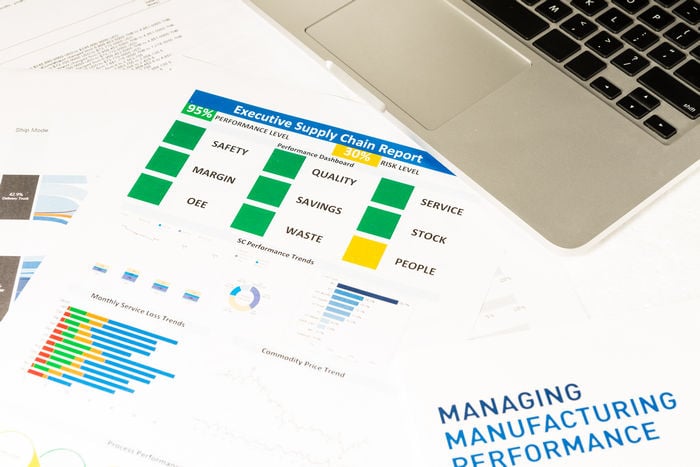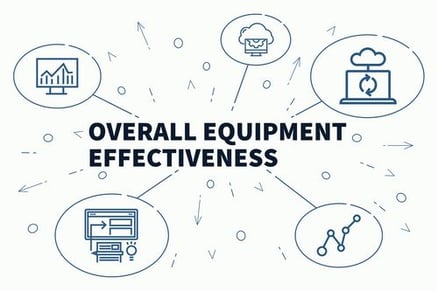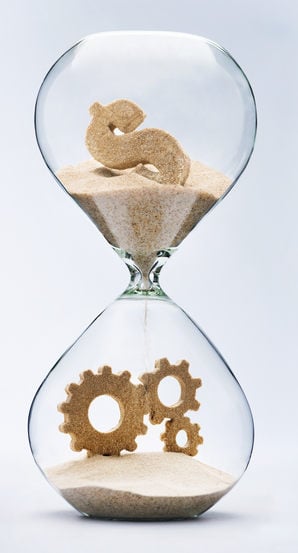
Key Performance Indicators (KPIs) help measure the performance and effectiveness of different areas within a company. KPIs are very specific to each industry and company. The best KPIs will depend on the company's specific goals and objectives. In a manufacturing context.
Here are some widely used KPIs:
Overall Equipment Effectiveness (OEE):
 This KPI measures how well a manufacturing unit performs relative to its designed capacity during the periods when it is scheduled to run.
This KPI measures how well a manufacturing unit performs relative to its designed capacity during the periods when it is scheduled to run.
OEE is calculated as the product of its three constituent parts: Availability, Performance, and Quality. Here are some strategies to improve each component of OEE:
- Improve Availability: This measures the percentage of scheduled time that the operation is available. Some tactics to improve availability include:
- Minimize Equipment Downtime: This could involve proactive maintenance, using predictive analytics to prevent equipment failures, or improving processes for changing over machinery.
- Effective Scheduling: Optimize production planning and scheduling to minimize idle time.
- Improve Response Times: Establish rapid response protocols to address equipment failures as quickly as possible.
- Improve Performance: This quantifies speed loss, or the gap between the actual and the maximum possible manufacturing speed.
- Eliminate Bottlenecks: Identify and resolve bottlenecks in the production process that may slow down overall operation.
- Increase Operational Efficiency: Use Lean manufacturing principles to streamline operations and reduce waste.
- Enhance Machine Speed: Upgrade or improve machinery where possible to enhance speed without compromising quality.
- Improve Quality: This factor measures the good units produced as a percentage of the total units started.
- Enhance Quality Control: Strengthen quality control processes to catch defects early, so less time is wasted on producing defective units.
- Train Employees: Regular training and education of employees can lead to improved workmanship and fewer defects.
- Improve Process Consistency: Standardizing work processes can lead to fewer variations and more products manufactured to specification.
It is essential to consider all three components of OEE together (Availability, Performance, and Quality). Improvements in one area (e.g., speed) should not come at the expense of another (e.g., quality or availability). In addition, while OEE is a valuable benchmark, it shouldn't be used in isolation. Always consider OEE in the context of other KPIs and overall business goals.
Yield:
Yield measures the number of products you manufacture without defects or rework. This can be tracked for the entire production process or stages within the process.
First Pass Yield (FPY):
This measures the percentage of products coming out of a process requiring no rework, directly indicating quality.
 Cycle Time:
Cycle Time:
This KPI measures the total time from the beginning to the end of your process, as defined by you and your customer. It includes process time, during which a unit is acted upon to bring it closer to an output and delay time, during which a unit of work is spent waiting to take the next action.
Reducing cycle time can lead to increased productivity and reduced costs. Here are several strategies to improve cycle time:
- Process Improvement: Utilize Lean or Six Sigma methodologies to eliminate waste and streamline processes.
- Automation: Implementing automation can significantly reduce cycle time. However, balancing the Cost of automation with the expected gains is essential. (Your CFO can help you evaluate this.)
- Bottleneck Analysis: Identify and address bottlenecks in your production process. This could mean upgrading or adding equipment, redistributing workloads, or other changes to smooth the flow of work.
- Training: Regularly train employees to ensure they have the necessary skills and knowledge to perform their jobs effectively and efficiently.
- Maintenance: Regular preventative maintenance can minimize downtime and ensure equipment runs at its optimal speed.
- Parallel Processing: Where possible, arrange for tasks to be completed simultaneously rather than sequentially to cut down on total cycle time.
- Supplier Management: Work closely with suppliers to ensure timely raw materials and parts are delivered. Delays in the supply chain can significantly increase cycle times.
- Changeover Reduction: Minimize the time it takes to switch from producing one product to another. Techniques like Single-Minute Exchange of Die (SMED) can be helpful here.
- Quality Improvement: Increase the focus on quality to reduce rework, which adds to the cycle time.
- Use of Technology: Utilize advanced technologies such as AI, IoT, and real-time tracking systems to gain instant visibility into the production process and act quickly on inefficiencies.
NOTE: While reducing cycle time can improve efficiency, it should not come at the Cost of quality or worker safety. It's also crucial to involve employees in improving cycle time, as they are often the ones who best understand the process and can provide valuable insights.
Scrap Rate:
This KPI measures the percentage of materials sent to production that end up as scrap.
Labor as a percentage of Cost:
This KPI measures how much of the total operational costs are due to labor. A higher number could indicate potential inefficiencies in the production process.
Inventory Turnover:
This ratio shows how often a company has sold and replaced inventory during a given period. A low turnover may lead to overstocking, obsolescence, or deficiencies in the product line or marketing effort.
Capacity Utilization:
This KPI measures the rate at which potential output levels are being met or used. Lower capacity utilization rates can indicate a problem with the system.
Order Fulfillment Cycle Time:
This KPI measures how long it takes for customers to receive a product after they've placed an order.
Return on Assets (ROA):
This KPI indicates how profitable a company is relative to its total assets. It tells you what earnings were generated from invested capital (assets).
The formula for Return on Assets (ROA) in manufacturing is straightforward and not specific to just manufacturing; it can be applied across various industries. ROA is calculated as follows:
Return on Assets (ROA) = Net Income / Average Total Assets
Where:
- Net Income is the company's profit after all expenses and taxes have been deducted from the revenue.
- Average Total Assets is the average value of the company's assets during the analyzed period. It can be calculated as (Beginning Total Assets + Ending Total Assets) / 2.
For a manufacturing company, the Net Income should reflect all the costs associated with manufacturing, including the Cost of goods sold, operating expenses, depreciation, and taxes.
ROA tells you how efficiently a company uses its assets to generate profits. A higher ROA indicates more efficient use of assets, while a lower ROA might suggest inefficiencies or underutilization of assets.
In a manufacturing context, you may also want to consider asset turnover as a complementary metric, which is calculated as:
Asset Turnover = Sales Revenue / Average Total Assets
This tells you how much revenue is generated for each dollar of assets and can be a valuable metric for comparing manufacturing companies or tracking efficiency improvements over time.
Safety Incident Rate:
This KPI measures the frequency of injuries in the workplace per a certain number of hours worked.
It's essential to remember that while KPIs are valuable for providing a numerical snapshot of a company's performance, they do not capture everything necessary about a company's situation or performance.
Why is it so challenging to create KPIs for manufacturing businesses?
Creating KPIs for a manufacturing business, while crucial, can indeed be a challenging task. Here are a few reasons why:
- The Complexity of Operations: Manufacturing processes often involve complex steps and stages, each needing to be measured and evaluated separately. This complexity can make it difficult to create simple, easily understood KPIs.
- Variety of Processes: Manufacturing businesses often have a wide range of processes that can be quite different from one another. A KPI that works well for one process might not be relevant or useful for another.
- Integration and Interdependency: Many manufacturing processes are interconnected and depend on each other. Changes in one process can have ripple effects on others. Therefore, KPIs need to be carefully designed to reflect these interdependencies and to ensure that improvement in one area does not negatively affect another.
- Data Collection Challenges: Accurate and reliable KPIs require accurate and reliable data. However, collecting the necessary data can be challenging, especially in complex and fast-paced manufacturing environments. Inadequate or outdated data collection systems can lead to inaccurate KPIs.
- Aligning with Strategic Goals: KPIs should ideally reflect the business's strategic goals. However, translating high-level business objectives into specific, measurable KPIs can be difficult. There can be a disconnect between what the business wants to achieve and what the KPIs are measuring.
- Balancing Efficiency and Quality: It's often challenging to create KPIs that balance efficiency and speed with the need for high-quality output. For example, a KPI focused on reducing production time might inadvertently lead to more mistakes and lower quality.
- Continuous Improvement: In a manufacturing setting, processes continually change and improve. Therefore, KPIs must also be continuously evaluated and revised, adding complexity.
Despite these challenges, manufacturing companies need to have a robust set of KPIs. The key is to select a few critical, relevant, and measurable KPIs that align with the company's strategic objectives. Furthermore, businesses should invest in effective data collection and analysis systems to support their KPIs.
Do I need a CFO to create KPIs for a manufacturing business?
 A Chief Financial Officer (CFO) can undoubtedly play a critical role in creating KPIs for a manufacturing business due to their deep understanding of financial data and overall business strategy. The CFO often has the necessary experience and perspective to ensure that KPIs align with the company's financial objectives and strategic goals.
A Chief Financial Officer (CFO) can undoubtedly play a critical role in creating KPIs for a manufacturing business due to their deep understanding of financial data and overall business strategy. The CFO often has the necessary experience and perspective to ensure that KPIs align with the company's financial objectives and strategic goals.
However, having a CFO to develop effective KPIs is not strictly necessary. The task of establishing KPIs can possibly be handled by other roles, such as:
- Operations Manager: An operations manager understands the production process in detail and can define critical operational metrics like yield, cycle time, and scrap rate.
- Quality Manager: They can establish KPIs related to product quality, such as first-pass yield or the number of defects.
- Supply Chain Manager: They can develop KPIs related to inventory, such as turnover rates or stock-outs.
- Safety Manager: They can define safety-related KPIs like the number of workplace accidents or near-misses.
- CEO or Business Owner: They can create high-level KPIs that track the business's overall performance, like revenue growth or market share.
- Management Accountant or Financial Analyst: They can help create financial KPIs like gross margin or return on assets.
In addition, smaller businesses without a CFO might rely on external resources like consultants or accounting firms to help establish and track KPIs.
Regardless of who creates the KPIs, it's essential to have buy-in from all stakeholders, including employees on the production floor. Everyone in the organization should understand the KPIs, why they are essential, and how they can contribute to improving them.
The team at CFO Selections has the expertise you need to develop KPIs.
Don't hesitate to reach out to us!
Whether you're an aspiring manager or a seasoned executive, the KPI metrics outlined in our eBook will provide key insights to better understand key performance indicators.







